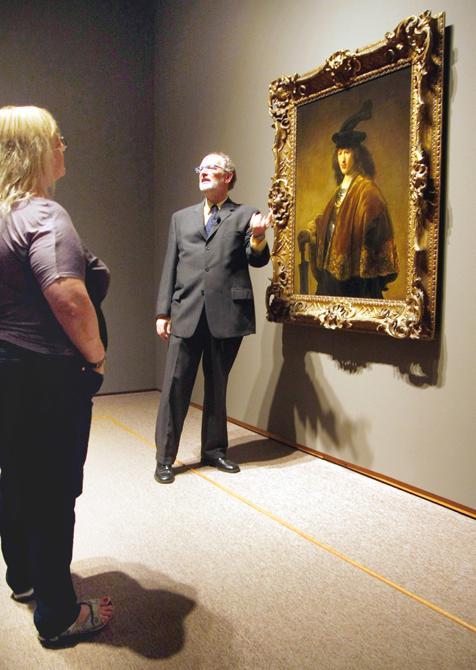
© NCSU Student Media 2012
Touring the works he helped curate for the Rembrandt in America exhibit at the N.C. Museum of Art, Dennis Weller, curator of northern European art, explains to patrons the details of the Dutch painter Rembrandt van Rijn's life Thursday, Oct. 27, 2011. The Exhibit opened Sunday in the East building on the museum and features 30 autographed Rembrandt paintings from across America. Photo by Tim O'Brien.
From Oct. 30 to Jan. 22, Raleigh was home to the largest collection of Rembrandt paintings ever presented in an American exhibition. The Rembrandt in America exhibition at the North Carolina Museum of Art drew widespread acclaim and even larger crowds in a short period of time, but putting the exhibition together was no quick feat.
“Our curator of Northern European art, Dennis Weller, had the idea for the exhibition around five years ago,” Natalie Braswell , Assistant Marketing Manager at the North Carolina Museum of Art, said. “It is a tremendous undertaking to get that many Rembrandt pieces in one place. The conversations with other museums and lenders were happening years before the exhibition was even announced. Rembrandt in America activated the NCMA staff at all levels to be highly involved; every department from curatorial to marketing to security had to be performing at a major level to accommodate the interest in the exhibition.”
The response was well worth the time and effort. Rembrandt in America was a runaway hit for the museum and art world.
“North Carolina was very receptive to the exhibition,” Braswell said. “We welcomed guests from every single county in the entire state, and on [Jan. 21] the exhibition was a record-breaking day for us with attendance at 7,212 people.”
One of these guests was Aryn Leach, a freshman in industrial design. She attended both the private opening gala for the Rembrandt in America exhibition and a school-organized tour with a private docent.
“As my father is a museum director, I’ve grown up in the art world, studying and learning about it. I’ve been familiar with Rembrandt for a long time and when I heard that there was an exhibition here, I just had to go,” Leach said. “I distinctly remember that there was one room filled with only a few Rembrandts and the rest of the artwork was painted by other apprentices and students. It was really interesting to be able to detect which ones were true Rembrandts and which ones were not.”
Leach said Rembrandt’s work is very dark, but also very emotional. “I find it interesting how he plays on blurring lines and textures and creates something so important to the painting, whether it’s just a simple black hat that mostly consists of flat tones,” Leach said.
Bethany Minervino , a senior in art and design, is also a fan of Rembrandt’s work.
“Part of the reason Rembrandt’s self portraits are so lively is because of all that detail; it is all created in one cohesive message about the subject,” Minervino said. “It was more than just a picture, more than just pointing a camera and clicking at a perceived reality.”
When totaled up, the logistics are impressive.
“We had 150,905 visitors to Rembrandt in America,” Braswell said. “Of those, we’ve had visitors from all 50 states and the District of Columbia; from all 100 counties in North Carolina; and from more than 40 foreign countries.”
The Rembrandt in America exhibition was a significant presence in the art world for more than one reason.
“Rembrandt in America is the largest collection of Rembrandt paintings ever assembled in the U.S.” Braswell said. “It is currently at the Cleveland Museum of Art, but it kicked off in Raleigh at our museum. Two of the non-Rembrandt works are from the NCMA’s permanent collection; the remaining works are on loan from private collections and more than two dozen American art museums.”
The exhibit has also attracted visitors because of its academic appeal. “Rembrandt in America is also the first major exhibition to explore how the desire for Rembrandt paintings by American collectors in turn fueled critical connoisseurship and research about the artist’s work,” Braswell said. “It attracted international attention from Rembrandt scholars, collectors and fans.”
It was an exhibition that rarely ceased to delight from beginning to end.
“As a design student I especially noticed the title wall for the exhibition was this beautiful plum color with old-fashioned gold print and it was just gorgeous,” Leach said. “It was a beautiful introduction to the whole exhibition because of the style and how well everything was presented. It was a great primer for what you were about to see.”